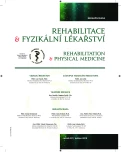Neuropathy of n. suprascapularis
Authors:
R. Orenčák 1; S. Onušková 1; A. Onuška 2; M. Janičko 3; Ž. Macejová
Authors‘ workplace:
REHAPRO, Michalovce
1; RDG s. r. o., Michalovce
2; I. Interná klinika UNLP, Košice
3
Published in:
Rehabil. fyz. Lék., 22, 2015, No. 2, pp. 80-84.
Category:
Case Report
Overview
Recourse:
Prevalence of the shoulder pains joint in a common population varies between 7 and 26%. In is one of the most frequent pain localizations within the framework of locomotor apparatus diseases.
Objective:
the introduction of a significantly underdiagnosed clinical unit – neuropathy of n. suprascapularis as a source of decreased functioning and painful afferentation in the shoulder joint and to refer to etiopathogenetic links in the origin of the damage.
Cohort and methods:
the case study of a 21 years old patient who developed neuropathy of n. suprascapularis through a traction mechanism.
Results:
diagnosis of the neuropathy of n. suprascapularis underwent a historical evolution. A diagnosis per exclusionem has been accepted for a long time. The development of diagnostic and imaging methods attached a greater importance to this clinic unit. Insufficient recognition of the cause of clinical symptoms resulted in failing therapeutic intervention on one hand and it could secondarily damage the patient in case of incorrectly indicated invasive therapeutic method son the other hand. Therefore, exact recognition of the causes of disease state was considered of primary importance, while invasive therapeutic interventions should follow only after a thorough differential diagnostic consideration.
Keywords:
occupational therapy, activities of daily living, functional abilities, prevocational rehabilitation, International Classification of Funkcioning, Disability and Health
Sources
1. ACEDO, A. A., ANTUNES, A. C., DOS SANTOS, A. B., DE OLVEIRA, C. B. et al.: Upper trapezius relaxation induced by tens and interferential current in computer users with chronic nonspecific neck discomfort: An electromyographic analysis. J. Back Musculoskelet. Rehabil., 27, 2014.
2. ANTONIADIS, G., RICHTER, H.-P., RATH, S., BRAUN, V. et al.: Suprascapular nerve entrapment: experience with 28 cases. Journal of Neurosurgery, 85, 1996, 6, 1020-1025.
3. BOYKIN, R. E., FRIEDMAN, D. J., HIGGINS, L. D., WARNER J. J.: Suprascapular neuropathy. J. Bone Joint Surg., 92, 2010, 13, s. 2348-2364.
4. BOYKIN, R. E., FRIEDMAN, D. J., ZIMMER, Z. R., OAKLANDER, A. L. et al.: Suprascapular neuropathy in a shoulder referral practice. J. Shoulder Elbow Surg., 20, 2011, 6, s. 983-988.
5. FANSA, H., SCHNEIDER, W.: Suprascapular nerve entrapment]. Handchir. Mikrochir. Plast. Chir., 35, 2003, 2, s. 122-126.
6. KOPPEL, H., THOMPSON, W.: Peripheral entrapment neuropathies of the lower extremity. N. Engl. J. Med., 262, 1960, s. 56-60.
7. LAJTAI, G., WIESER, K., OFNER, M., RAIMANN, G. et al.: Electromyography and nerve conduction velocity for the evaluation of the infraspinatus muscle and the suprascapular nerve in professional beach volleyball players. Am. J. Sports Med., 40, 2012, 10, s. 2303-2308.
8. LINSELL, L., DAWSON, J., ZONDERVAN, K., ROSE, P. et al.: Prevalence and incidence of adults consulting for shoulder conditions in UK primary care; patterns of diagnosis and referral. Rheumatology (Oxford), 45, 2006, 2, s. 215-221.
9. PIATT, B. E., HAWKINS, R. J., FRITZ, R. C., HO, C. P. et al.: Clinical evaluation and treatment of spinoglenoid notch ganglion cysts. J. Shoulder Elbow Surg., 11, 2002, 6, s. 600-604.
10. PIEBER, K., HERCEG, M., FIALKA, C. OBERLEITNER, G. et al.:Is suprascapular neuropathy common in high-performance beach volleyball players? A retrospective analysis. Wien Klin Wochenschr, 6, 2014.
11. SEO, Y. J., LEE, Y. J., KIM, J. S, . LIM, S. H. et al.: Brachial plexus neuritis associated with Streptococcus agalactiae infection: A Case Report. Ann Rehabil. Med., 38, 2014, 4, s. 563-567.
12. SHISHIDO, H., KIKUCHI, S.: Injury of the suprascapular nerve in shoulder surgery: an anatomic study. J. Shoulder Elbow Surg., 10, 2001, 4, s. 372-376.
13. STAAL, J. B., DEBIE, R. A., HENDRIKS, E. J.: Aetiology and management of work-related upper extremity disorders. Best Pract. Res. Clin. Rheumatol., 21, 2007, 1, s. 123-133.
14. VORSTER, W., LANGE, C. P. BRIET, R. J., LABUSCHAGNE, B. C. et al.: The sensory branch distribution of the suprascapular nerve: an anatomic study. J. Shoulder Elbow Surg., 17, 2008, 3, s. 500-502.
15. WALSWORTH, M. K., MILLS, J. T., MICHENER, L. A.: Diagnosing suprascapular neuropathy in patients with shoulder dysfunction: a report of 5 cases. Phys. Ther., 84, 2004, 4, s. 359-372.
Labels
Physiotherapist, university degree Rehabilitation Sports medicineArticle was published in
Rehabilitation & Physical Medicine

2015 Issue 2
- Hope Awakens with Early Diagnosis of Parkinson's Disease Based on Skin Odor
- Deep stimulation of the globus pallidus improved clinical symptoms in a patient with refractory parkinsonism and genetic mutation
Most read in this issue
- Fatigue Fracture in the Physiotherapist and Physician Practice
- The Effect of Acral Coactivation Therapy on Expiratory Muscle Strength and Lower-chest-wall Motion
- Diagnostics and Basic Principles of Dysphagia Therapy after Resection of Oropharyngeal Region Tumors
- The Use of Biofeedback in Rehabilitation in Patients with Gait Disorders after Stroke
